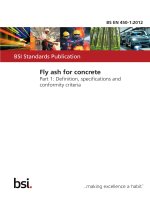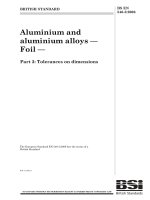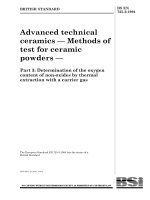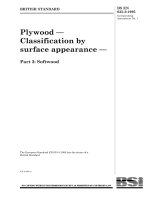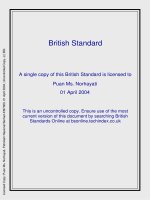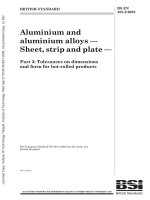Bsi bs en 61969 3 2012
Bạn đang xem bản rút gọn của tài liệu. Xem và tải ngay bản đầy đủ của tài liệu tại đây (1.09 MB, 18 trang )
BS EN 61969-3:2012
BSI Standards Publication
Mechanical structures for
electronic equipment —
Outdoor enclosures
Part 3: Environmental requirements,
tests and safety aspects
BRITISH STANDARD
BS EN 61969-3:2012
National foreword
This British Standard is the UK implementation of EN 61969-3:2012. It is
identical to IEC 61969-3:2011. It supersedes BS EN 61969-3:2001 which is
withdrawn.
The UK participation in its preparation was entrusted to Technical Committee
EPL/48, Electromechanical components and mechanical structures for
electronic equipment.
A list of organizations represented on this committee can be obtained on
request to its secretary.
This publication does not purport to include all the necessary provisions of a
contract. Users are responsible for its correct application.
© The British Standards Institution 2012
Published by BSI Standards Limited 2012
ISBN 978 0 580 67587 4
ICS 31.240
Compliance with a British Standard cannot confer immunity from
legal obligations.
This British Standard was published under the authority of the Standards
Policy and Strategy Committee on 29 February 2012.
Amendments issued since publication
Amd. No.
Date
Text affected
BS EN 61969-3:2012
EUROPEAN STANDARD
EN 61969-3
NORME EUROPÉENNE
February 2012
EUROPÄISCHE NORM
ICS 31.240
Supersedes EN 61969-3:2001
English version
Mechanical structures for electronic equipment Outdoor enclosures Part 3: Environmental requirements, tests and safety aspects
(IEC 61969-3:2011)
Structures mécaniques pour équipement
électronique Enveloppes de plein air Partie 3: Exigences environnementales,
essais et aspects de la sécurité
(CEI 61969-3:2011)
Mechanische Bauweisen für elektronische
Einrichtungen Außengehäuse Teil 3: Umgebungsanforderungen,
Prüfungen und Sicherheitsaspekte
(IEC 61969-3:2011)
This European Standard was approved by CENELEC on 2011-12-22. CENELEC members are bound to comply
with the CEN/CENELEC Internal Regulations which stipulate the conditions for giving this European Standard
the status of a national standard without any alteration.
Up-to-date lists and bibliographical references concerning such national standards may be obtained on
application to the CEN-CENELEC Management Centre or to any CENELEC member.
This European Standard exists in three official versions (English, French, German). A version in any other
language made by translation under the responsibility of a CENELEC member into its own language and notified
to the CEN-CENELEC Management Centre has the same status as the official versions.
CENELEC members are the national electrotechnical committees of Austria, Belgium, Bulgaria, Croatia, Cyprus,
the Czech Republic, Denmark, Estonia, Finland, France, Germany, Greece, Hungary, Iceland, Ireland, Italy,
Latvia, Lithuania, Luxembourg, Malta, the Netherlands, Norway, Poland, Portugal, Romania, Slovakia, Slovenia,
Spain, Sweden, Switzerland, Turkey and the United Kingdom.
CENELEC
European Committee for Electrotechnical Standardization
Comité Européen de Normalisation Electrotechnique
Europäisches Komitee für Elektrotechnische Normung
Management Centre: Avenue Marnix 17, B - 1000 Brussels
© 2012 CENELEC -
All rights of exploitation in any form and by any means reserved worldwide for CENELEC members.
Ref. No. EN 61969-3:2012 E
BS EN 61969-3:2012
EN 61969-3:2012
-2-
Foreword
The text of document 48D/483/FDIS, future edition 2 of IEC 61969-3, prepared by SC 48D, "Mechanical
structures for electronic equipment", of IEC/TC 48, "Electromechanical components and mechanical
structures for electronic equipment" was submitted to the IEC-CENELEC parallel vote and approved by
CENELEC as EN 61969-3:2012.
The following dates are fixed:
•
•
latest date by which the document has
to be implemented at national level by
publication of an identical national
standard or by endorsement
latest date by which the national
standards conflicting with the
document have to be withdrawn
(dop)
2012-09-22
(dow)
2014-12-22
This document supersedes EN 61969-3:2001.
EN 61969-3:2012 includes the following significant technical changes with respect to EN 61969-3:2001:
Table 1 and Table 6 have been extended with requirements and tests, relevant for outdoor conditions.
Attention is drawn to the possibility that some of the elements of this document may be the subject of
patent rights. CENELEC [and/or CEN] shall not be held responsible for identifying any or all such patent
rights.
Endorsement notice
The text of the International Standard IEC 61969-3:2011 was approved by CENELEC as a European
Standard without any modification.
BS EN 61969-3:2012
EN 61969-3:2012
-3-
Annex ZA
(normative)
Normative references to international publications
with their corresponding European publications
The following documents, in whole or in part, are normatively referenced in this document and are
indispensable for its application. For dated references, only the edition cited applies. For undated
references, the latest edition of the referenced document (including any amendments) applies.
NOTE When an international publication has been modified by common modifications, indicated by (mod), the relevant EN/HD
applies.
Publication
Year
IEC 60068
Title
EN/HD
Year
Series Environmental testing
EN 60068
Series
IEC 60417
Database
Graphical symbols for use on equipment
-
-
IEC 60529
-
Degrees of protection provided by enclosures (IP Code)
-
IEC 60695-11-10
-
EN 60695-11-10
Fire hazard testing Part 11-10: Test flames - 50 W horizontal and
vertical flame test methods
-
IEC 60721-3-2
-
Classification of environmental conditions Part 3: Classification of groups of
environmental parameters and their
severities - Section 2: Transportation
EN 60721-3-2
-
IEC 60721-3-4
-
EN 60721-3-4
Classification of environmental conditions Part 3: Classification of groups of
environmental parameters and their
severities - Section 4: Stationary use at nonweatherprotected locations
-
IEC 60825-1
-
Safety of laser products Part 1: Equipment classification and
requirements
EN 60825-1
-
IEC 60950
Series Information technology equipment - Safety
EN 60950
Series
IEC 61010
-
Safety requirements for electrical equipment EN 61010
for measurement, control and laboratory use
-
IEC 61140
-
Protection against electric shock - Common
aspects for installation and equipment
EN 61140
-
IEC 61439-5
-
Low-voltage switchgear and controlgear
assemblies Part 5: Assemblies for power distribution in
public networks
EN 61439-5
-
IEC 61587-1
-
EN 61587-1
Mechanical structures for electronic
equipment - Tests for IEC 60917 and IEC
60297 Part 1: Climatic, mechanical tests and safety
aspects for cabinets, racks, subracks and
chassis
-
IEC 61587-2
-
Mechanical structures for electronic
equipment - Tests for IEC 60917 and
IEC 60297 Part 2: Seismic tests for cabinets and racks
-
EN 61587-2
BS EN 61969-3:2012
EN 61969-3:2012
-4-
Publication
Year
Title
IEC 61587-3
-
EN 61587-3
Mechanical structures for electronic
equipment - Tests for IEC 60917 and
IEC 60297 Part 3: Electromagnetic shielding performance
tests for cabinets, racks and subracks
-
IEC 62194
-
Method of evaluating the thermal
performance of enclosures
EN 62194
-
IEC 62262
-
Degrees of protection provided by enclosures EN 62262
for electrical equipment against external
mechanical impacts (IK code)
-
IEC 62305-4
-
EN 62305-4
Protection against lightning Part 4: Electrical and electronic systems within
structures
-
ISO 2533
-
Standard atmosphere
-
ISO 3744
-
Acoustics - Determination of sound power
EN ISO 3744
levels of noise sources using sound pressure Engineering method in an essentially free field
over a reflecting plane
-
ISO 3864
-
Safety colours and safety signs
-
-
ISO 4892-2
-
Plastics - Methods of exposure to laboratory
light sources Part 2: Xenon-arc lamps
EN ISO 4892-2
-
ETSI EN 300019-2-2 -
EN/HD
-
Equipment Engineering (EE) - Environmental conditions and environmental tests for
telecommunications equipment Part 2-2: Specification of environmental tests Transportation
Year
-
–2–
BS EN 61969-3:2012
61969-3 © IEC:2011
CONTENTS
INTRODUCTION ..................................................................................................................... 5
1
Scope ............................................................................................................................... 6
2
Normative references ....................................................................................................... 6
3
Terms and definitions ....................................................................................................... 7
4
Classification of environmental conditions ........................................................................ 7
5
Test conditions ................................................................................................................. 8
6
5.1 General ................................................................................................................... 8
5.2 Climatic tests .......................................................................................................... 8
5.3 Biological tests ........................................................................................................ 8
5.4 Tests of resistance against chemically active substances ........................................ 9
5.5 Tests of resistance against mechanically active substances .................................... 9
Mechanical tests............................................................................................................... 9
7
6.1 General ................................................................................................................... 9
6.2 Dynamic test ......................................................................................................... 10
6.3 Lifting and stiffness test ........................................................................................ 10
Safety aspects ................................................................................................................ 11
8
7.1 General ................................................................................................................. 11
7.2 Locking devices ..................................................................................................... 11
7.3 Vandalism resistance ............................................................................................ 11
7.4 Bullet resistance (optional) .................................................................................... 12
Seismic requirements ..................................................................................................... 12
9
Electromagnetic shielding performance .......................................................................... 12
10 Thermal management ..................................................................................................... 12
11 Noise emission ............................................................................................................... 12
Table 1 – Climatic conditions for environmental classes 1 and 2 ............................................. 8
Table 2 – Biological tests ........................................................................................................ 8
Table 3 – Tests of resistance against chemically active substances ........................................ 9
Table 4 – Tests of resistance against mechanically active substances .................................... 9
Table 5 – Vibration and shock test ........................................................................................ 10
Table 6 – Safety aspects ...................................................................................................... 11
BS EN 61969-3:2012
61969-3 © IEC:2011
–5–
INTRODUCTION
IEC 61969-3 Ed.2.0 provides basic environmental test requirements to be used in the
absence of local regulatory or application specific environmental test requirements. This
provides manufacturers and users of generic outdoor enclosure solutions with minimum
performance compliance criteria; thermal solutions pending on the environment an outdoor
enclosure is subjected to. Since forced air heat dissipation and acoustic noise are closely
related, noise limitations are typically defined by local regulatory limitations.
Typically, it becomes the responsibility of the outdoor enclosure vendor to provide a solution
for thermal management within the local regulatory noise limitations.
–6–
BS EN 61969-3:2012
61969-3 © IEC:2011
MECHANICAL STRUCTURES FOR ELECTRONIC EQUIPMENT –
OUTDOOR ENCLOSURES –
Part 3: Environmental requirements, tests and safety aspects
1
Scope
This part of IEC 61969 specifies a set of basic environmental requirements and tests, as well
as safety aspects for outdoor enclosures under conditions of non-weatherprotected locations
above ground.
The purpose of this standard is to define a minimum level of environmental performance in
order to meet requirements of storage, transport and final installation. It is the intention to
establish basic environmental performance criteria for outdoor enclosure compliance.
2
Normative references
The following referenced documents are indispensable for the application of this document.
For dated references, only the edition cited applies. For undated references, the latest edition
of the referenced document (including any amendments) applies.
IEC 60068 (all parts), Environmental testing
IEC 60417, Graphical symbols for use on equipment
IEC 60529, Degrees of protection provided by enclosures (IP code)
IEC 60695-11-10, Fire hazard testing – Part 11-10: Test flames – 50 W horizontal and vertical
flame test methods
IEC 60721-3-2, Classification of environmental conditions – Part 3: Classification of groups of
environmental parameters and their severities – Section 2: Transportation
IEC 60721-3-4, Classification of environmental conditions – Part 3: Classification of groups of
environmental parameters and their severities – Section 4: Stationary use at non-weatherprotected locations
IEC 60825-1, Safety of laser products – Part 1: Equipment specification and requirements
IEC 60950 (all parts), Information technology equipment – Safety
IEC 61010, Safety requirements for electrical equipment for measurement, control, and
laboratory use
IEC 61140 Protection against electric shock - Common aspects for installation and equipment
IEC 61439-5, Low-voltage switchgear and control gear assemblies – Part 5: Assemblies for
power distribution in public networks
IEC 61587-1, Mechanical structures for electronic equipment – Tests for IEC 60917 and
IEC 60297 – Part 1, Climatic, mechanical tests and safety aspects for cabinets, racks,
subracks and chassis
BS EN 61969-3:2012
61969-3 © IEC:2011
–7–
IEC 61587-2, Mechanical structures for electronic equipment – Tests for IEC 60917 and
60297 – Part 2: Seismic tests for cabinets and racks
IEC 61587-3, Mechanical structures for electronic equipment – Tests for IEC 60917 and
IEC 60297 – Part 3: Electromagnetic shielding performance tests for cabinets, racks and
subracks
IEC 62194, Methods of evaluating the thermal performance of enclosures
IEC 62262, Degrees of protection provided by enclosures for electrical equipment against
external mechanical impacts (IK code)
IEC 62305-4, Protection against lightning – Part 4: Electrical and electronic systems within
structures
ISO 2533, Standard atmosphere
ISO 3744, Acoustics – Determination of sound power levels and sound energy levels of noise
sources using sound pressure – Engeneering methods for an essentially free field over a
reflecting plane
ISO 3864, Graphical symbols – Safety colours and safety signs
ISO 4892-2, Plastics – Methods of exposure to laboratory light sources – Part 2: Xenon-arc
lamps
ETSI EN 300019-2-2, Equipment Engineering (EE);Environmental
environmental tests for telecommunications equipment; Part 2-2:
environmental tests; Transportation
3
conditions and
Specification of
Terms and definitions
For the purposes of this document, the following terms and definitions apply.
3.1
outdoor enclosure
enclosure exposed to the outdoor environment, for stationary use at non-weatherprotected
locations, for the protection of electronic equipment installed inside against outdoor
environmental conditions
3.2
non-weatherprotected location
place with direct weather influence
4
Classification of environmental conditions
The environmental conditions are derived from IEC 60721-3-4, with the focus on empty
outdoor enclosures relevant requirements.
Class 1: Non-weatherprotected location: Covers all regions with a moderate climate.
Class 2: Non-weatherprotected locations, extended: Covers all regions with severe climate.
BS EN 61969-3:2012
61969-3 © IEC:2011
–8–
The individual outdoor enclosure product solution tested to these basic environmental test
requirements my claim compliance to either Class 1 or Class 2 or a combination of
Class1/Class2.
5
5.1
Test conditions
General
The basic test conditions shown in Table 1; Table 2; Table 3 and Table 4 reflect typical
outdoor enclosure environments to be endured.
5.2
Climatic tests
Table 1 – Climatic conditions for environmental classes 1 and 2
Environmental parameters
Test severity
Class 1
Duration
IEC method
Class 2
a
Low air temperature
-45 °C
-65 °C
16 h
60068-2-1; A
b
High air temperature
80 °C
90 °C
16 h
60068-2-2: B
c
Damp heat
30 °C, 93 %
30 °C, 93 %
96 h
60068-2-78: Cb
d
Rate of change of
temperature
-50 °C to + 23 °C
-50 °C to + 23 °C
2 cycles
60068-2-14: Nb
1 °C/min
1 °C/min
1 120 W/m 2
72 h/ 40 °C
60068-2-5 Sa
96 h
60068-2-30: Db
W/m 2
e
Solar radiation
1 120
f
Condensation
40 °C
40 °C
90 % to 100 %
RH
90 % to 100 % RH
g
Precipitation (rain, snow,
hail, dust, etc.)
IP 54
IP 55
-
60529
h
Movement of the
surrounding air
50 m/s
60 m/s
-
-
i
Formation of ice and frost
Yes
Yes
-
-
j
Ultraviolet degradation test
Yes
Yes
-
ISO 4892-2
NOTE For comparable conditions the International Standard Air, in accordance to ISO 2533 (15 °C at 1 013,
25 hPa) shall be used.
Following the test, compliance is checked by visual inspection of the internal and external
parts; no rust, cracking or other deterioration shall be detected with impact to the required
function; no ingress of water. Hinges, locks and handles for example shall be in operating
condition. The test in accordance with Table 1, item i shall prove that access to the internal
equipment is possible without causing permanent degradation of protection levels.
5.3
Biological tests
Table 2 – Biological tests
Environmental
parameters
Test severity
Class 1
Purpose
IEC method
Class 2
a
Flora: Presence of mould,
fungus, etc.
Yes
Yes
b
Fauna: Presence of
rodents and others harmful
to the equipment
Yes, but without
termites
Yes, but with
termites
To check the
material for
resistance
60068-2-10
BS EN 61969-3:2012
61969-3 © IEC:2011
–9–
Following the test, compliance is checked by visual inspection.
5.4
Tests of resistance against chemically active substances
Table 3 – Tests of resistance against chemically active substances
(Similar to IEC 60721-3-4, Class 4C2)
Environmental parameters
a
Salts: Sea and road salt mist
b
Sulphur dioxide
a
Test severity
Class 1
Class 2
Mean value
Maximum value
Yes, at 35 °C,5 % NaCl
0,3
mg/m 3
0,11
c
Hydrogen sulphide
d
a
Chlorine
e
Nitrogen oxides
a
a
cm 3
1,0
/m 3
0,071 cm 3 /m 3
0,36 cm 3 /m 3
0,1 mg/m 3
0,3 mg/m 3
0,034 cm 3 /m
0,1 cm 3 /m 3
60068-2-11; Ka
10 days
60068-2-60; Ke
1,0 mg/m 3
0,26 cm 3 /m 3
a
4 days
0,37 cm 3 /m 3
0,5 mg/m 3
0,5
IEC method
mg/m 3
0,1 mg/m 3
mg/m 3
Duration
0,52 cm 3 /m 3
The tests may be performed by a four component mixture of these gases. Tests of Table 3 may be combined
with tests of Table 1.
Following the test, compliance is checked by visual inspection of the outside of the used
materials or coatings. Surface corrosion of the protective enclosure is allowed. The enclosure
design shall provide protection for electromagnetic gaskets and earthing contacts where no
corrosion is permitted.
5.5
Tests of resistance against mechanically active substances
Table 4 – Tests of resistance against mechanically active substances
Environmental parameters
Test severity
IEC method
Classes 1 and 2
a
Sand
b
Dust (suspension)
IP 50
c
Dust (sedimentation)
(see note)
NOTE
No measurable dust shall have entered the enclosure (this assessment is more severe than IEC 60529).
60529
Following the test, compliance is checked by visual inspection.
6
6.1
Mechanical tests
General
The purpose of these mechanical tests is to ensure that the outdoor enclosure will withstand
handling, storage, transport and protect installed equipment from exposure to mechanical
stress. For seismic compliance see Clause 8. Installations in public areas typically require
compliance to more severe local regulatory laws. These and any additional application
BS EN 61969-3:2012
61969-3 © IEC:2011
– 10 –
specific requirements need to be observed. Should the outdoor enclosure be installed in a
public place the power input requirements may have to be in compliance with IEC 61439-5.
6.2
Dynamic test
The dynamic tests of an outdoor enclosure shall be conducted under the intended transport
condition. Since outdoor enclosure dynamic transport stress is considerably more severe than
typical handling and storage stress no further dynamic tests are required. For the purpose of
this test no transport packing material is used. The outdoor enclosure shall be mounted to the
shock/vibration table by using the intended ground/floor mounting features. For the purpose of
the dynamic test the outdoor enclosure static load shall be agreed between the vendor and
user.
The chosen severity classes are similar to IEC 60721-3-2, class 2M1.
Table 5 – Vibration and shock test
Test severity
Environmental parameters
ETSI EN
Class 1
(controlled transport
condition)
a
b
Vibration, sinusoidal
3 axes, 10 cycles
1)
Vibration, random
Class 2
(limited transport
condition)
2-9 Hz/3, 5 mm
displacement
5-9 Hz/3,5 mm
displacement
9-200 Hz/10 m/s 2
9-200 Hz/10 m/s 2
acceleration
acceleration
200-500 Hz/15 m/s 2
200-500 Hz/15 m/s 2
acceleration
acceleration
-
5-20 Hz: 1 m 2 /s4/Hz
20-200 Hz: -3 dB/oct
1
IEC method/
60068-2-6: Fc
ETSI EN 300019-2-2
Class 2.3
c
Shock , / 2 sine wave
vertical axes only
No of shocks: 3
Peak acceleration
100 m/s 2
Time: 11 ms
Peak acceleration
100 m/s 2
Time: 11 ms
60068-2-27: Ea
Shock response
spectrum type I
d
Free fall:
enclosure mass < 20 kg
20 kg to 100 kg
> 100 kg
0, 25 m
0, 25 m
0, 10 m
1, 25 m
1, 00 m
0, 25 m
60068-2-32: Ed
1)
Alternative test.
Following the test, no deformation or damage of parts that effect form, fit and function shall be
found.
6.3
Lifting and stiffness test
If lifting eyes are provided the performance test as per IEC 61587-1 shall be applied.
Following the test, no deformation or damage of parts that effect form, fit and function shall be
found.
BS EN 61969-3:2012
61969-3 © IEC:2011
7
7.1
– 11 –
Safety aspects
General
General safety requirements: The outdoor enclosure shall consider adequate design
considerations to be of danger and hazard to people and prevent unauthorized access.
To protect authorized personnel (assembly, installation, test and maintenance) the outdoor
enclosure shall be free of defects such as sharp edges, burrs, etc. Compliance to IEC 60950
is required.
Regulatory safety requirements:
The outdoor enclosure shall comply with the local enforced regulatory safety requirements.
Table 6 – Safety aspects
Requirement
Earth bonding
The responsibility of the vendor is
to provide sufficient conductivity
between different parts of the
enclosure and means for the
Test specification
Using IEC 60950 and IEC 61439-5
for equipped enclosure
IEC 61010/60825
earth bonding of equipment
IEC 61140
Lightning strike
To be observed in the total “Earth
bonding” concept
IEC 62305-4
Mechanical safety
IK-Code according to IEC 62262
For testing IEC 60068-2-75
Vandalism
Requirements shall be part of the
vendor specification
Tests may be part of the vendor
specification
Warning labels
General warning, caution, risk of
danger
ISO 3864, B.3.1
Caution, risk of life
Caution, risk of electric shock
Caution, hot surface
ISO 3864, B.3.2
ISO 3864, B.3.6
IEC 60417
Security, vandalism protection
Requirements for the resistance of
the enclosure and the locking
devices against unauthorised
access
Tests may be part of the user
specifications
Flammability
Material properties may be
specified by user
IEC 60695-11-10
7.2
Locking devices
Outdoor enclosure access locking functions such as used on doors, covers, roofs, etc. are
application and/or regulatory specific. The outdoor enclosure shall have the capability to be
locked and unlocked only by authorized crafts people.
7.3
Vandalism resistance
Outdoor enclosure vandalism resistance required on any locking functions such as used with
doors, covers, roofs, etc. are application and/or regulatory specific. The outdoor enclosure
shall provide for heavy duty key locking and hinges hardware.
– 12 –
BS EN 61969-3:2012
61969-3 © IEC:2011
Compliance check: The outdoor enclosure shall be resistant to unauthorized access by the
use of typical tools such as screw drivers, pliers, hammers, etc.
7.4
Bullet resistance (optional)
Outdoor enclosure bullet resistance is application and/or regulatory specific.
The outdoor enclosure shall be designed for withstanding a 12 gauge shotgun blast of
No. 7 ½ shot at a distance of 15 m without penetration of the enclosure wall by any pellets.
Test procedure:
The enclosure shall be positioned as in a typical installation and all unique vertical surfaces
shall be subjected to a blast from a 12 gauge shotgun with No. 7 ½ size shot fired at a
distance of 15 m. The load used shall be a high brass shell fired from an improved or modified
choke barrel.
Assessment following the test: The outer skin of the enclosure may be deformed but still
maintaining the protection, without any protrusions.
8
Seismic requirements
Outdoor enclosure seismic compliance is application and/or regulatory specific. If seismic
compliance is requested, tests shall be conducted in accordance with IEC 61587-2.
9
Electromagnetic shielding performance
This
requirement
is
optional,
dependent
on
the
area
where
needed.
If electromagnetic shielding compliance is required, test should be conducted in accordance
with IEC 61587-3 unless otherwise specified.
10 Thermal management
For the operation of electronic equipment housed in outdoor enclosures passive and/or active
thermal management devices are used. Since the active heat management devices typically
include fans, noise emission may have to comply with local regulatory requirements.
Preferably, outdoor enclosure heat management should be based on convection air cooling
(passive). If environmental compliance testing is required, tests should be conducted in
accordance with IEC 62194 unless otherwise specified.
11 Noise emission
The final location of the installed outdoor enclosure will determine the noise limits tolerated.
Typically, regional and location specific regulatory requirements are in place. Sound power
noise tests shall be conducted in accordance with ISO 3744, unless otherwise specified.The
noise may be generated by the installed equipment and/or by thermal management solutions.
To simplify the approval process it is always recommended to explore the possibilities of
passive convection cooling first. This may be achieved by applying strategically placed heat
sinks and/or double wall enclosure designs. Power emission, thermal management and noise
limitations will have to be considered for the final application.
___________
This page deliberately left blank
This page deliberately left blank
NO COPYING WITHOUT BSI PERMISSION EXCEPT AS PERMITTED BY COPYRIGHT LAW
British Standards Institution (BSI)
BSI is the national body responsible for preparing British Standards and other
standards-related publications, information and services.
BSI is incorporated by Royal Charter. British Standards and other standardization
products are published by BSI Standards Limited.
About us
Revisions
We bring together business, industry, government, consumers, innovators
and others to shape their combined experience and expertise into standards
-based solutions.
Our British Standards and other publications are updated by amendment or revision.
The knowledge embodied in our standards has been carefully assembled in
a dependable format and refined through our open consultation process.
Organizations of all sizes and across all sectors choose standards to help
them achieve their goals.
Information on standards
We can provide you with the knowledge that your organization needs
to succeed. Find out more about British Standards by visiting our website at
bsigroup.com/standards or contacting our Customer Services team or
Knowledge Centre.
Buying standards
You can buy and download PDF versions of BSI publications, including British
and adopted European and international standards, through our website at
bsigroup.com/shop, where hard copies can also be purchased.
If you need international and foreign standards from other Standards Development
Organizations, hard copies can be ordered from our Customer Services team.
Subscriptions
Our range of subscription services are designed to make using standards
easier for you. For further information on our subscription products go to
bsigroup.com/subscriptions.
With British Standards Online (BSOL) you’ll have instant access to over 55,000
British and adopted European and international standards from your desktop.
It’s available 24/7 and is refreshed daily so you’ll always be up to date.
You can keep in touch with standards developments and receive substantial
discounts on the purchase price of standards, both in single copy and subscription
format, by becoming a BSI Subscribing Member.
PLUS is an updating service exclusive to BSI Subscribing Members. You will
automatically receive the latest hard copy of your standards when they’re
revised or replaced.
To find out more about becoming a BSI Subscribing Member and the benefits
of membership, please visit bsigroup.com/shop.
With a Multi-User Network Licence (MUNL) you are able to host standards
publications on your intranet. Licences can cover as few or as many users as you
wish. With updates supplied as soon as they’re available, you can be sure your
documentation is current. For further information, email
BSI Group Headquarters
389 Chiswick High Road London W4 4AL UK
We continually improve the quality of our products and services to benefit your
business. If you find an inaccuracy or ambiguity within a British Standard or other
BSI publication please inform the Knowledge Centre.
Copyright
All the data, software and documentation set out in all British Standards and
other BSI publications are the property of and copyrighted by BSI, or some person
or entity that owns copyright in the information used (such as the international
standardization bodies) and has formally licensed such information to BSI for
commercial publication and use. Except as permitted under the Copyright, Designs
and Patents Act 1988 no extract may be reproduced, stored in a retrieval system
or transmitted in any form or by any means – electronic, photocopying, recording
or otherwise – without prior written permission from BSI. Details and advice can
be obtained from the Copyright & Licensing Department.
Useful Contacts:
Customer Services
Tel: +44 845 086 9001
Email (orders):
Email (enquiries):
Subscriptions
Tel: +44 845 086 9001
Email:
Knowledge Centre
Tel: +44 20 8996 7004
Email:
Copyright & Licensing
Tel: +44 20 8996 7070
Email:
